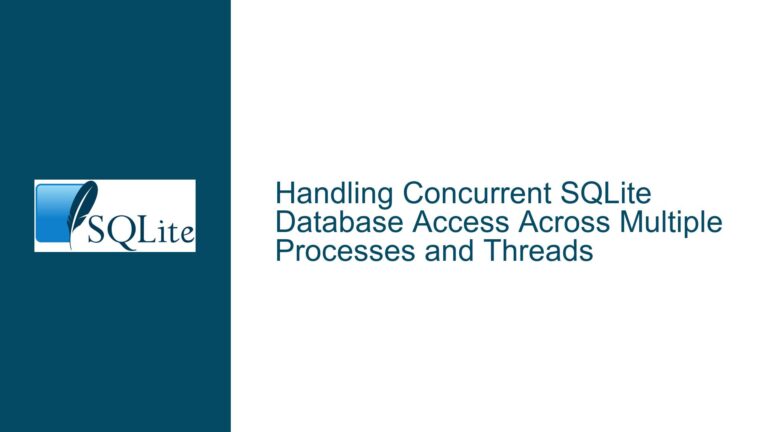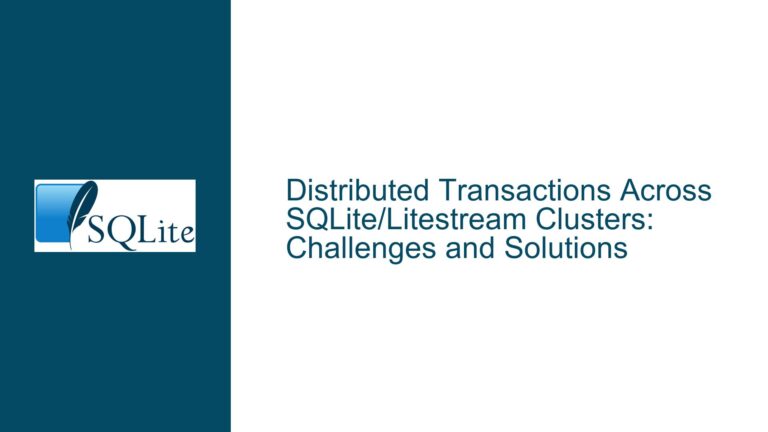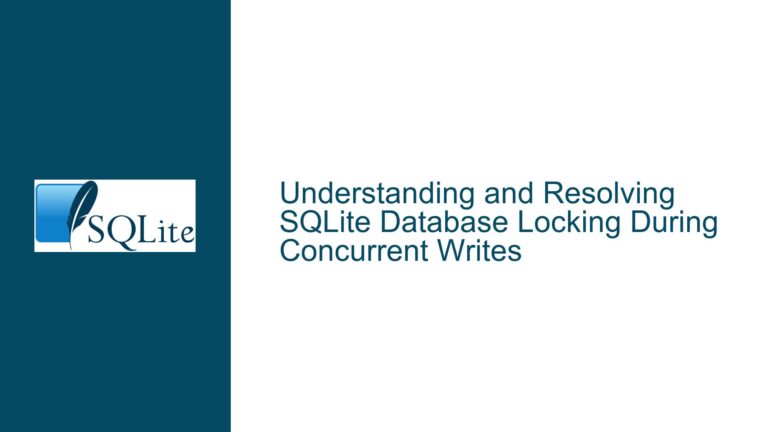SQLite Multithreading Support and Thread Safety Modes
Multithreading in SQLite: Default SERIALIZED Mode and Its Implications
SQLite is a widely used embedded database engine known for its simplicity, reliability, and lightweight nature. One of the key features of SQLite is its support for multithreading, which allows applications to perform database operations concurrently across multiple threads. However, this feature comes with certain nuances that developers must understand to avoid data corruption, race conditions, and other concurrency-related issues.
By default, SQLite operates in the SERIALIZED threading mode. This means that SQLite internally enforces strict serialization of database operations across all connections, ensuring that only one thread can access a database connection at any given time. This default behavior is designed to prevent programming errors that could lead to data corruption or crashes. The SERIALIZED mode is the safest option for most applications, as it eliminates the need for developers to implement their own thread synchronization mechanisms.
The SERIALIZED mode works by using internal mutexes to lock database connections during critical sections of code. When a thread attempts to execute a query or modify the database, SQLite acquires a lock on the connection, preventing other threads from accessing it until the operation is complete. This ensures that all database operations are executed in a thread-safe manner, even if multiple threads attempt to access the same connection simultaneously.
However, the SERIALIZED mode does come with a performance overhead. The internal locking mechanism adds a small delay to each database operation, as SQLite must acquire and release locks for every query. For most applications, this overhead is negligible, but in high-performance scenarios where thousands of queries are executed per second, it can become a bottleneck.
Risks of Changing SQLite Threading Modes: MULTITHREAD and SINGLETHREAD
While the default SERIALIZED mode provides robust thread safety, SQLite also offers two alternative threading modes: MULTITHREAD and SINGLETHREAD. These modes can be enabled using the sqlite3_config API or by compiling SQLite with specific options. However, changing the threading mode introduces additional complexity and risks that developers must carefully consider.
The MULTITHREAD mode allows multiple threads to access the same database connection simultaneously, but it places the responsibility of thread synchronization on the developer. In this mode, SQLite does not enforce any internal locking, meaning that concurrent access to a database connection can lead to race conditions, data corruption, or crashes if proper synchronization mechanisms are not implemented. Developers using the MULTITHREAD mode must use external mutexes or other synchronization primitives to ensure that only one thread accesses a database connection at a time.
The SINGLETHREAD mode, on the other hand, disables all internal thread synchronization mechanisms in SQLite. This mode assumes that all database operations will be performed on a single thread, and it is the developer’s responsibility to ensure that no other threads attempt to access the database. While this mode eliminates the overhead of internal locking, it severely restricts the application’s ability to perform concurrent database operations. Using SINGLETHREAD mode in a multithreaded application can lead to undefined behavior, including crashes and data corruption.
Changing the threading mode from SERIALIZED to MULTITHREAD or SINGLETHREAD can improve performance in certain scenarios, but it also increases the risk of data corruption and application instability. Developers must weigh the benefits of reduced overhead against the potential risks and ensure that they have implemented robust thread synchronization mechanisms if they choose to use a non-default threading mode.
Best Practices for Multithreading in SQLite: Configuring and Testing Thread Safety
To ensure safe and efficient multithreading in SQLite, developers should follow a set of best practices for configuring and testing thread safety. These practices include understanding the implications of each threading mode, implementing proper synchronization mechanisms, and thoroughly testing the application to identify and resolve concurrency issues.
First, developers should carefully consider whether the default SERIALIZED mode meets their application’s performance and concurrency requirements. For most applications, the overhead of internal locking is negligible, and the benefits of automatic thread safety outweigh the performance costs. If the application requires higher performance and the developer is confident in their ability to manage thread synchronization, the MULTITHREAD mode can be used with caution.
When using the MULTITHREAD mode, developers must implement external synchronization mechanisms to prevent concurrent access to database connections. This can be achieved using mutexes, semaphores, or other synchronization primitives provided by the programming language or framework. Each database connection should be protected by a mutex, and threads must acquire the mutex before performing any database operations. This ensures that only one thread can access the connection at a time, preventing race conditions and data corruption.
Developers should also consider using connection pooling to manage database connections in a multithreaded environment. Connection pooling allows the application to reuse existing connections instead of creating a new connection for each query, reducing the overhead of connection establishment and teardown. When using connection pooling, each connection in the pool should be protected by a mutex to ensure thread safety.
Thorough testing is essential to identify and resolve concurrency issues in a multithreaded SQLite application. Developers should perform stress testing by simulating high levels of concurrent database access and monitoring the application for crashes, data corruption, or performance degradation. Automated testing tools can be used to generate a large number of concurrent queries and verify that the application behaves correctly under load.
In addition to stress testing, developers should use SQLite’s built-in diagnostic tools to detect potential issues. The PRAGMA integrity_check command can be used to verify the integrity of the database, while the PRAGMA locking_mode command can be used to monitor the locking behavior of database connections. These tools can help developers identify and resolve issues before they lead to data corruption or application crashes.
Finally, developers should document their threading model and synchronization mechanisms to ensure that other team members understand the application’s concurrency requirements. Clear documentation can help prevent accidental changes to the threading mode or synchronization logic, reducing the risk of introducing concurrency issues in future updates.
By following these best practices, developers can ensure that their SQLite applications are both thread-safe and performant, providing a reliable and efficient data storage solution for multithreaded environments.






